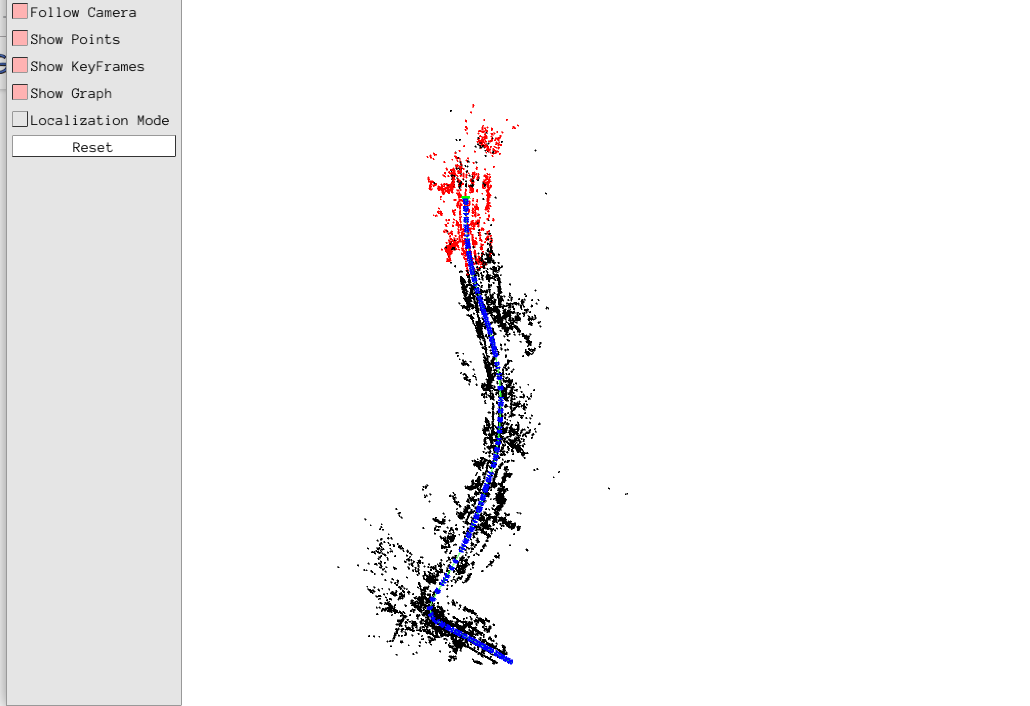UPDATE: This repo is no longer maintained now. Please refer to https://github.com/jiexiong2016/GCNv2_SLAM if you are intereseted in SLAM with deep learning image descriptors.
NOTE: SuperPoint-SLAM is not guaranteed to outperform ORB-SLAM. It's just a trial combination of SuperPoint and ORB-SLAM. I release the code for people who wish to do some research about neural feature based SLAM.
This repository was forked from ORB-SLAM2 https://github.com/raulmur/ORB_SLAM2. SuperPoint-SLAM is a modified version of ORB-SLAM2 which use SuperPoint as its feature detector and descriptor. The pre-trained model of SuperPoint come from https://github.com/MagicLeapResearch/SuperPointPretrainedNetwork.
See LICENSE file.
We have tested the library in Ubuntu 12.04, 14.04 and 16.04, but it should be easy to compile in other platforms. A powerful computer (e.g. i7) will ensure real-time performance and provide more stable and accurate results.
We use the new thread and chrono functionalities of C++11.
We use Pangolin for visualization and user interface. Dowload and install instructions can be found at: https://github.com/stevenlovegrove/Pangolin.
We use OpenCV to manipulate images and features. Dowload and install instructions can be found at: http://opencv.org. Required at leat 2.4.3. Tested with OpenCV 2.4.11 and OpenCV 3.2.
Required by g2o (see below). Download and install instructions can be found at: http://eigen.tuxfamily.org. Required at least 3.1.0.
We use modified versions of DBoW3 (instead of DBoW2) library to perform place recognition and g2o library to perform non-linear optimizations. Both modified libraries (which are BSD) are included in the Thirdparty folder.
We use Pytorch C++ API to implement SuperPoint model. It can be built as follows:
git clone --recursive -b v1.0.1 https://github.com/pytorch/pytorch
cd pytorch && mkdir build && cd build
python ../tools/build_libtorch.pyIt may take quite a long time to download and build. Please wait with patience.
NOTE: Do not use the pre-built package in the official website, it would cause some errors.
Clone the repository:
git clone https://github.com/KinglittleQ/SuperPoint_SLAM.git SuperPoint_SLAM
We provide a script build.sh to build the Thirdparty libraries and SuperPoint_SLAM. Please make sure you have installed all required dependencies (see section 2). Execute:
cd SuperPoint_SLAM
chmod +x build.sh
./build.sh
This will create libSuerPoint_SLAM.so at lib folder and the executables mono_tum, mono_kitti, mono_euroc in Examples folder.
TIPS:
If cmake cannot find some package such as OpenCV or EIgen3, try to set XX_DIR which contain XXConfig.cmake manually. Add the following statement into CMakeLists.txt before find_package(XX):
set(XX_DIR "your_path")
# set(OpenCV_DIR "usr/share/OpenCV")
# set(Eigen3_DIR "usr/share/Eigen3")You can download the vocabulary from google drive or BaiduYun (code: de3g). And then put it into Vocabulary directory. The vocabulary was trained on Bovisa_2008-09-01 using DBoW3 library. Branching factor k and depth levels L are set to 5 and 10 respectively.
-
Download the dataset (grayscale images) from http://www.cvlibs.net/datasets/kitti/eval_odometry.php
-
Execute the following command. Change
KITTIX.yamlby KITTI00-02.yaml, KITTI03.yaml or KITTI04-12.yaml for sequence 0 to 2, 3, and 4 to 12 respectively. ChangePATH_TO_DATASET_FOLDERto the uncompressed dataset folder. ChangeSEQUENCE_NUMBERto 00, 01, 02,.., 11.
./Examples/Monocular/mono_kitti Vocabulary/ORBvoc.txt Examples/Monocular/KITTIX.yaml PATH_TO_DATASET_FOLDER/dataset/sequences/SEQUENCE_NUMBER
Here are the evaluation results of monocular benchmark on KITTI using RMSE(m) as metric.
| Seq. | Dimension | ORB | SuperPoint |
|---|---|---|---|
| 00 | 564 x 496 | 5.33 | X |
| 01 | 1157 × 1827 | X | X |
| 02 | 599 × 946 | 21.28 | X |
| 03 | 471 × 199 | 1.51 | 1.04 |
| 04 | 0.5 × 394 | 1.62 | 0.35 |
| 05 | 479 × 426 | 4.85 | 3.73 |
| 06 | 23 × 457 | 12.34 | 14.27 |
| 07 | 191 × 209 | 2.26 | 3.02 |
| 08 | 808 × 391 | 46.68 | 39.63 |
| 09 | 465 × 568 | 6.62 | X |
| 10 | 671 × 177 | 8.80 | 5.31 |
If you find this useful, please cite our paper.
@inproceedings{deng2019comparative,
title={Comparative Study of Deep Learning Based Features in SLAM},
author={Deng, Chengqi and Qiu, Kaitao and Xiong, Rong and Zhou, Chunlin},
booktitle={2019 4th Asia-Pacific Conference on Intelligent Robot Systems (ACIRS)},
pages={250--254},
year={2019},
organization={IEEE}
}

